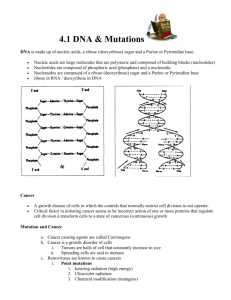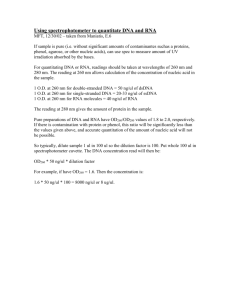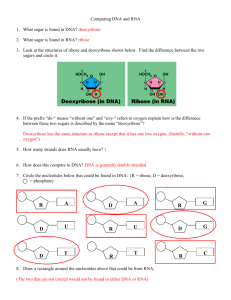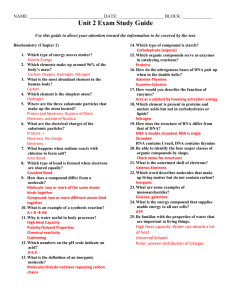Vielas sasta•v no si•ka•m dal•in•a•m, un katrai no ta•m piemi•t s•i•s
advertisement
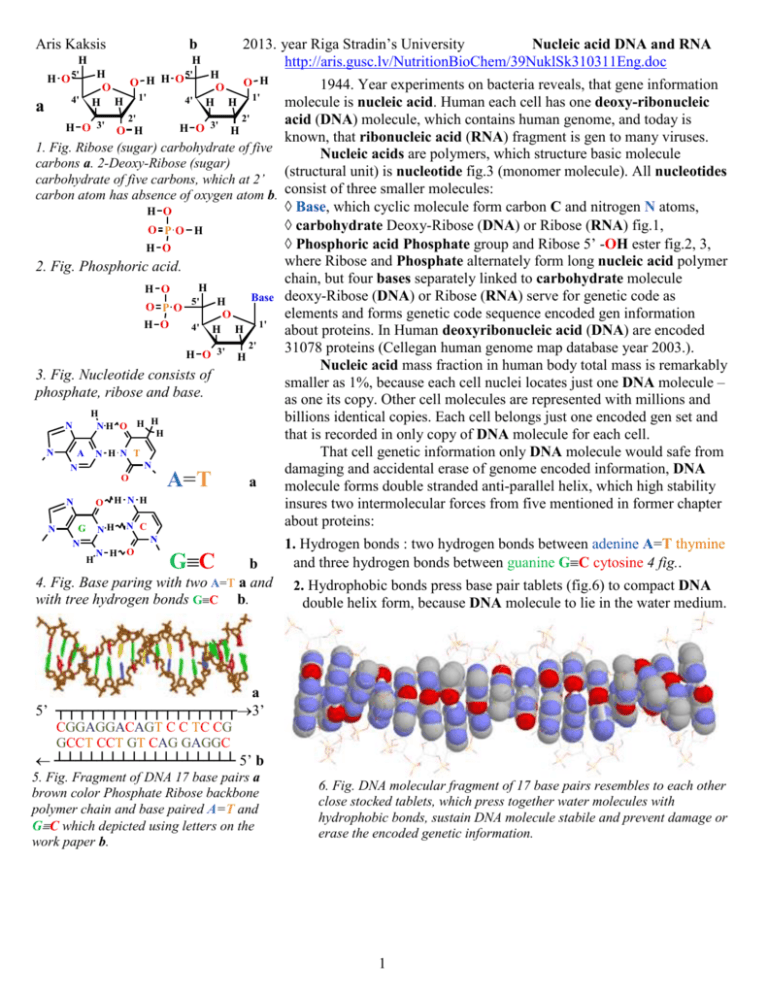
b Aris Kaksis H H O 5' 2013. year Riga Stradin’s University Nucleic acid DNA and RNA http://aris.gusc.lv/NutritionBioChem/39NuklSk310311Eng.doc H 5' H O H H O O 4' H H 1' H O H O H H 1' 1944. Year experiments on bacteria reveals, that gene information molecule is nucleic acid. Human each cell has one deoxy-ribonucleic a 2' 2' acid (DNA) molecule, which contains human genome, and today is H O 3' O H H O 3' H known, that ribonucleic acid (RNA) fragment is gen to many viruses. 1. Fig. Ribose (sugar) carbohydrate of five Nucleic acids are polymers, which structure basic molecule carbons a. 2-Deoxy-Ribose (sugar) (structural unit) is nucleotide fig.3 (monomer molecule). All nucleotides carbohydrate of five carbons, which at 2’ carbon atom has absence of oxygen atom b. consist of three smaller molecules: Base, which cyclic molecule form carbon C and nitrogen N atoms, H O carbohydrate Deoxy-Ribose (DNA) or Ribose (RNA) fig.1, O PO H Phosphoric acid Phosphate group and Ribose 5’ -OH ester fig.2, 3, H O where Ribose and Phosphate alternately form long nucleic acid polymer 2. Fig. Phosphoric acid. chain, but four bases separately linked to carbohydrate molecule H H O Base deoxy-Ribose (DNA) or Ribose (RNA) serve for genetic code as 5' H O PO elements and forms genetic code sequence encoded gen information O 1' H O 4' H H about proteins. In Human deoxyribonucleic acid (DNA) are encoded 2' 31078 proteins (Cellegan human genome map database year 2003.). H O 3' H Nucleic acid mass fraction in human body total mass is remarkably 3. Fig. Nucleotide consists of smaller as 1%, because each cell nuclei locates just one DNA molecule – phosphate, ribose and base. as one its copy. Other cell molecules are represented with millions and H billions identical copies. Each cell belongs just one encoded gen set and N NH O H H H that is recorded in only copy of DNA molecule for each cell. N That cell genetic information only DNA molecule would safe from H N A N T N N damaging and accidental erase of genome encoded information, DNA O A=T a molecule forms double stranded anti-parallel helix, which high stability N O H N H insures two intermolecular forces from five mentioned in former chapter about proteins: G NH N C N 4' N N N H O GC b 4. Fig. Base paring with two A=T a and with tree hydrogen bonds GC b. H 1. Hydrogen bonds : two hydrogen bonds between adenine A=T thymine and three hydrogen bonds between guanine GC cytosine 4 fig.. 2. Hydrophobic bonds press base pair tablets (fig.6) to compact DNA double helix form, because DNA molecule to lie in the water medium. a 5’ ┬┬┬┬┬┬┬┬┬┬┬┬┬┬┬┬┬3’ CGGAGGACAGT C C TC CG GCCT CCT GT CAG GAGGC ┴┴┴┴┴┴┴┴┴┴┴┴┴┴┴┴┴ 5’ b 5. Fig. Fragment of DNA 17 base pairs a brown color Phosphate Ribose backbone polymer chain and base paired A=T and GC which depicted using letters on the work paper b. 6. Fig. DNA molecular fragment of 17 base pairs resembles to each other close stocked tablets, which press together water molecules with hydrophobic bonds, sustain DNA molecule stabile and prevent damage or erase the encoded genetic information. 1 Sugar molecules, which contain nucleic acid, give the name for it. If sugar is Ribose (7. fig. a), than name is ribonucleic acid RNA, if Deoxy-ribose 7. fig. b , than name is deoxy-ribonucleic acid DNA : Nucleic acids are on long chain linked nucleotides, in which Phosphoric acid Phosphate ester bonds linked to third carbon atom hydroxyl group -OH (fig.3,7) carbon atom polymer strand end 3’, as well as called three prime 3’ end. RNA molecules of Ribose sugar form single polynucleotide chain and RNA are single stranded molecules. Nucleic acid chains strand replication and transcription process direction fixes start from free Phosphate ester group H2PO4– at Ribose fifth carbon atom (fig.3,5), which called five prim 5’ end carbon atom, to finish at chain strand end, which locates free Ribose alcohol group -OH (fig.3,5) at tree prim 3’carbon atom. DNA molecule forms two anti parallel poly-nucleotide chains directions from 5’ to 3’ base pairs with bases on second chain anti-parallel direction from 3’ to 5’ (fig.5, 6). Therefore DNA is double stranded molecule, which called as double stranded helix (fig.5, 6). All Living cells encoded Homeostasis information molecules DNA and RNA carries distinguish functions to maintain organism stationary state equilibrium between environments. Two distinctions in DNA and RNA molecules: 1. Deoxy-ribose in DNA polymer sequence replaces Ribose in RNA molecule (7 Fig.), 2. thymine bases in nucleotides of DNA molecules replaced by uracil in nucleotides of RNA molecules 8 fig, Two by building of content and structure different form molecules DNA and RNA biological – chemical carry out distinctive functions in living cells, what secure living processes: 1. DNA molecule is double stranded anti-parallel polynucleotide, which form double helix, and in human cells locates just in nuclei. Influence, HIV viruses got in cell synthesize own DNA fragments, which immediately is integrated in cell nuclei of human DNA genome and newer escape of nuclei. 2. RNA molecules are single stranded polynucleotide chain and never form large double stranded helix molecules. RNA molecules form now in cell nucleus as now outside cell nucleus. Usually in RNA molecule genetic code recorded writing over from DNA molecule short fragment. Therefore from DNA 17 base pair fragment double helix (9 fig a) can get two antiparallels and complement RNA molecules RNA I and RNA II (9 fig b un c) with 17 bases in each separate strand. 57 2 H H O 5' 4' H 5' H H O H H O O H O O 1' 4' H H 1' H H H O 3' 2' O H H O 3' 2' H a b 7. Fig. Ribose (sugar) carbohydrate of five carbons a. 2-Deoxy-Ribose (sugar) carbohydrate of five carbons, which at 2’ carbon atom has absence of oxygen atom b. O H HN U N O O H H Uracil CH H N T N Thymine O 8 att. Thymine bases in DNA molecules are replaced with uracil in RNA molecules. 5’ ┬┬┬┬┬┬┬┬┬┬┬┬┬┬┬┬┬3’ CGGAGGACAGT C C TC CG GCCT CCT GT CAG GAGGC DNS ┴┴┴┴┴┴┴┴┴┴┴┴┴┴┴┴┴ 5’ a CGGAGGACAGU C C UC CG RNS I 5’ ┴┴┴┴┴┴┴┴┴┴┴┴┴┴┴┴┴3’ b GCCU CCU GU CAG GAGGC RNS II ┴┴┴┴┴┴┴┴┴┴┴┴┴┴┴┴┴ 5’ c 9. att. DNA 17 base pair fragment coupled bases A=T and GC 4 fig. which planar projections using letter symbols written on paper a and over written as projections of single stranded sequences RNA I b and RNA II c. 10. Nucleic acids DNA and RNA a b 5’ ┬┬┬┬┬┬┬┬┬┬┬┬┬┬┬┬┬3’ Aris Kaksis 2014. Year Riga Stradin’s University http://aris.gusc.lv/NutritionBioChem/38DNSLabEng310311.doc Nucleic acids mass fraction of common mass in human body is small, remarkably smaller as 1%, because in each cell nucleus present just one DNA copy of molecule. For other molecules of cells copy numbers are millions and billions identical copies. Each cell can have just one active encoded gene set and that is written in unique alone DNA molecules. DNA molecule forms double stranded helix and consist of four type nucleotides composed two type base pairs adenine=thymine and guaninecytosine, where each base pair is genetic coding unit: N O H N H CGG AGGA CAGT CCT CC G GCC T CCT GTCA GGA GG C ┴┴┴┴┴┴┴┴┴┴┴┴┴┴┴┴┴ 5’ c 23 Fig. a DNA fragment of 17 nucleotide base pairs and paired bases A=T and GC b lie between polymer double stranded chains of phosphate deoxy riboses, which depicted with colored letters can draw code sequence on planar paper and c. Cytosine C is red, guanine G is green, adenine A is blue and thymine T is yellow. H NH O H H H N N A N HN T H O deoxy ribose A=T deoxy ribose H N 5 deoxiribose H H O O PO 5' 4' 7 N 6 N H O O PO H O 5' 24. Fig. Base pair adenine=thymine is bind with two hydrogen bonds. Base pair guaninecytosine is bind with three hydrogen bonds. H O H O 5' H 4' 2' deoxy ribose H H O H H 4' 9 1' N N 3 H H N 3 4 2 N O 1 3' H H O H O P O 5' H O 4' deoxy ribose 2' H deoxiribose base adenine and thymine 1' H 6 N 1 7 H 4 2 8N O H O H H H O H 2' H O 3' H GC deoxy ribose 5 6 deoxiribose 2 1' O deoxiribose HH H 1 O PO N 5 deoxy ribose GC H 8N 4 N 3 9 H O H H H O 3' A=T deoxy ribose N H O Base is bind with nitrogen atom to first carbon atom of deoxy ribose monosaccharide, but at monosaccharide deoxy riboses fifth carbon hydroxyl group is bind phosphoric acid ester. H O deoxy ribose N C N N N N NH G N N H 3 2 5 4 N 6 N O 1 H O H H H O 3' H 1' 2' base guanine cytosine deoxy ribose Four nucleotides adenine, thymine, guanine and cytosine are encoding elements of genes on DNA chain double helix, which letter analogs are A T G C. Those letters original sequence is genetic code. DNA polymer chain in polycondensation reaction forms sequence phosphate 5’-deoxy ribose 3’- phosphate – 5’deoxy ribose 3’ – etc. In experiments on 1944.year with bacteria was discovered, that gene information molecule is nucleic acid. Every cell of human has one copy of set deoxyribonucleic acid (DNA) , which comprise human genome, and is discovered since 2003 human genome mapping, as well ribonucleic acid (RNS) fragment contains genes for many viruses. Nucleic acid is polymer, which structural unit, element, nucleotide Fig.28. (monomer molecule) makes polymer molecule. 3 H H O 5' 4' H 5' H H O H H O O H O O 1' 4' H H 1' H H H O 3' 2' H O 3' O H 2' H a b 26 Fig. Ribose five carbon and O atoms carbohydrate (sugar) a. Deoxy ribose five carbon atom carbohydrate (sugar) b, at 2’ carbon atom is absent oxygen O atom 2’-deoxy-ribose. H O O PO H H O 27. Fig. Phosphoric acid. H O O PO H O H 5' 4' Baze H O H H 1' H O 3' 2' H 28. Fig. Nucleotide consist of phosphate, ribose and base as genetic code symbol A, G, C, T, U adenine, guanine, cytosine, thymine and uracil. Nucleotide structure make three smaller molecules: one of five bases, which cyclic molecule forms carbon and nitrogen atoms, carbohydrate 2-deoxyribose in DNA or ribose in RNS Fig.26., phosphoric acid esters of phosphate groups with 5’ -OH group Fig.28. Nucleotide ribose and phosphate alternately forms long nucleic acid polymer chain, in which phosphoric acid second ester bond connects with next nucleotide on third carbon atom hydroxyl group -OH, which call one as three prim 3’ carbon position on end of chain. Nucleic acid chain string direction determines starting from free phosphate ester group H2PO4– at ribose fives carbon atom Fig.28 , which call as five prim 5’ on beginning of nucleic acid chain, to end of string, on which lies free spirit group -OH of ribose at carbon atom three prim 3’. Five bases laterally bind to first prim 1’ carbon atom of deoxy ribose (DNA) or of ribose (RNA) serve as genetic code elements and recover the encoded information sequence of genetic code about proteins. Human deoxy ribonucleic acid DNA has encoded 31078 proteins (Year 2003 Cellegan human genome mapping data). That would safeguard the genetic information on alone DNA molecule from damages and accidental encoded information in genes erasing, DNA molecule forms double helix of two antiparallel polynucleotide chains in direction from 5’ to 3’ with base pairing between chains on antiparallel direction from 3’ to 5’ Fig.23.c. Two intermolecular forces from five mentioned in former chapter 9 provide for high stability of DNA: hydrogen bonds and hydrophobic bonds in water medium press together base pair plates (Fig.23) in compact CGGA GGAC AGU CC UC CG RNA I stock of base pair plates as DNA antiparallel double stranded helix shape. 5’ ┴┴┴┴┴┴┴┴┴┴┴┴┴┴┴┴┴3’ a Two differences are found in DNA and RNS molecules. First is GCCU CCU GU CAG GAGGC RNA II sugar molecule, which is backbone member of nucleic acid, determines ┴┴┴┴┴┴┴┴┴┴┴┴┴┴┴┴┴ 5’ b O H H O uracil CH H c H N T HN U N N thymine O O what’s the name has. As sugar is ribose 26. Fig. a , than nucleic acid name is ribonucleic acid RNA, if deoxy ribose 26. Fig. b, than nucleic acid name is deoxy ribonucleic acid DNA. Second: uracil bases in RNA molecule replace position of thymine bases from DNA molecule 29 Fig. . Genetic code from DNA molecule to ribosome brings RNA polymer chain. RNA products of hydrolyze content is similar: adenine, 29. Fig. RNA I 17 bases chain fragment a uracil, guanine, cytosine, phosphate and ribose. Ribose at second carbon and RNS II 17 bases chain fragment b atom has hydroxyl group OH, but uracil instead thymine methyl group contains bases A adenines, U uracils, CH3 has hydrogen atom H. RNA polymer chain is phosphateG guanines and C cytosines, which 5’ribose 3’-phosphate– 5’ribose 3’- phosphate –5’ribose 3’– etc. depicted with letters drawn on plane Biological differences in DNA and RNA molecules cause two paper. In RNA thymine c replacing with chemical distinctions: deoxy ribose and ribose; thymine and uracil: uracil and deoxy ribose replacing with 1. DNA molecules have antiparallel polynucleotide chains, which ribose assign to RNA molecules distinct properties from DNA molecules. DNA form double helixes, and locate only in nucleus of human cells. Also localizes and never leave self location site influence or HIV viruses entrancing in cytosol of cell synthesize its DNA in nucleus of cell. DNA molecule forms fragment, which after immediately integrates in DNA genome of cell two antiparallel nucleotide chains double nucleus and never more can leave outside of cell nucleus back to cytosol. helix. Whereas RNA molecules are mono 2. RNA molecules are mono thread polynucleotide chains and thread polynucleotide chains and after never make long double helixes. RNA molecules form both in nucleus of transcription easy leave the nucleus of cell and outside cell nucleus. In RNA molecule encoded genetic cell in cytosol perform its functions information enzymes transcribe from DNA molecule code. . 4 Nucleus of animal, plant and human cells has one DNA. DNA is as instruction set, what regulates all cell functions. Cells reproduce dividing, etc. parent cell divides in two identical new cells and each new with own original parent nucleus copy. Before cell division, that biological proliferation, under government of enzymes DNA double helix rewinds and new DNA copy synthesis process of replication begins, that each new cell in division process would get original parent DNA copy. Replication enzymes read nucleotide original sequences and copy over information to two new DNA molecules, which receive each divided cell as original copy. Segment of DNA molecule (approximately 300÷34000 nucleotides), what encodes one protein synthesis in ribosome, calls one about gene. All in chromosomes being genes compendium calls one about genome. RNA molecule is synthesized in nucleus of cell, because enzymes unwind DNA double helix. RNA polymerases enzyme reads nucleotide sequence and copy it on messenger RNA molecule, which gets out from cell nucleus. Organic bases sequence of messenger mRNA molecule calls about gene, which contains information about amino acid sequence on protein chain. Synthesized messenger mRNA molecule binds to ribosome and initiates protein synthesis reaction. Protein synthesizes in ribosomes reading nucleotide sequence from messenger mRNA molecule. 20 amino acids transportation to ribosomes carry out 64 transport tRNA molecules. Each transport tRNA molecule chain thread backbone form 76 nucleotides with ester bonds between phosphate 5’ribose3’- phosphate – 5’ribose3’-phosphate – 5’ribose3’ – etc. Ribosome enzymes with polycondensation reactions translate to synthesized protein chain amino acids in correct sequence from encoded messenger mRNA gene sequence of organic bases set. Translation process in ribosomes start with amino acid methionine Met[M]. leading strand template Sliding clamp DNA polymerase on leading strand template newly synthesized strand DNA helicase T-antigene or cellular homologue T lagging strand template DNA primase New RNA primer New Okazaky fragment single strand DNA binding proteins Sliding clamp DNA polymerase on lagging strand template 30. Fig. DNA replication (reproduction) 5
